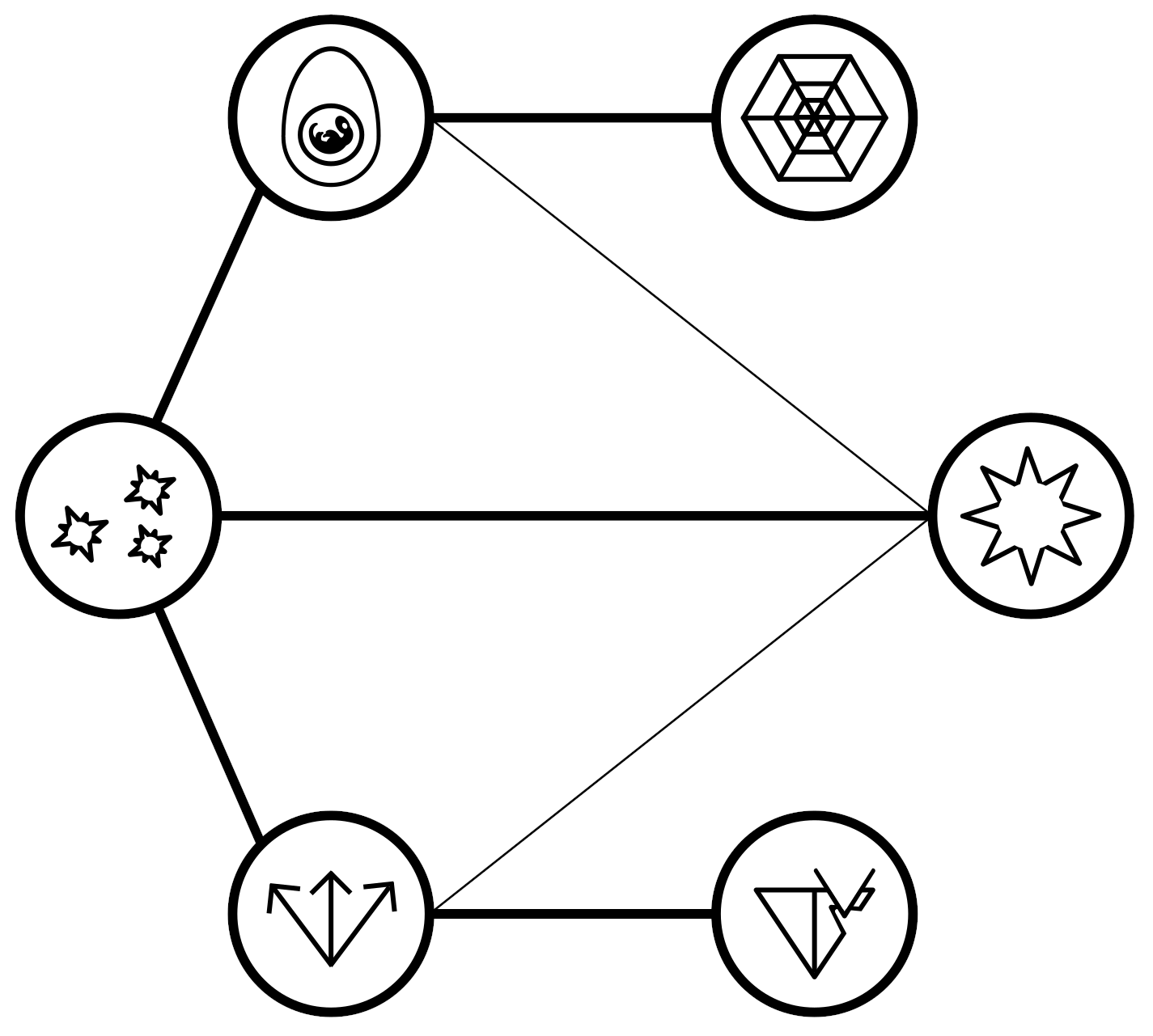Table of Contents
WARNING: This faith has not yet had a chance to become canonical.
Leksharia is a kavkem mythology best referred to as Death of Gods, even though its literal translation would be gone spirits (from the kavkem words lek and shari). As a faith, it does not stray far from the stories of Taaravahr.
It can be encountered all across Asheenagiji, but dominates in 'southern' Asheenagiji - at least in those areas where it hasn't been displaced by outright nihilistic atheism.
The faith has a presence in central Asheenagiji where Nitish Ynas dominates, but it's only worth noting as a flimsy memetic bridge between 'northern' and 'southern' Leksharia territories - a communicative bridge of more practical than spiritual value.
There are several flavours of Leksharia, three of which tend to be significantly widespread:
Kaar'heril (“cursed fate”) has a fairly scattered spread throughout the continent and is the only Leksharia faith one can encounter in the north of Asheenagiji. That said, the area it dominates in is the very 'southern' tip of Asheenagiji, where it is flanked by territories 'belonging' to the other two main Leksharia faiths.
Unsurprisingly, there is quite a wide memetic divide between Kaar'heril territories in equatorial Asheenagiji versus polar Asheenagiji, heavily influenced in mood by the faiths around them (Siri Akynkulla and Ne͡imakanaas̈ for the polar, competing Leksharia points of view for the equatorial).
Natehysik (“hope of the god(s)”) is most frequently encountered in the 'southwest' of Asheenagiji, including in the area around Tain, where it has an impressive spread in all directions, including into the desert stretches - assuming you manage to come across a kavkem there, which is a rare occurrence, they are almost without a doubt an adherent of Natehysik.
Dynashari (“destroyed spirits”) can be found along the whole 'southeastern' coastline, dominant in the centre of the same.
Cosmology
The adherents of Leksharia believe that the deities of the old pantheon, while they still exist, are part of an old generation of gods that, in sum, are in favour of the kavkema, but that Terenyira is the first (visible) replacement, and there will be more to come. Meanwhile the powers of the old deities will wane, and the allegiance of the world shifts more and more in favour of the Nayabaru.
Presumably this flavour of mythology arose from the vague knowledge that Ysikary used to exist, coupled with the strong knowledge that Tamas̈elu was once more powerful.
Sub-flavours of Leksharia include:
- Kaar'heril, in which Tkanetar is considered a new god. This typically radically rearranges the classical mythology, greatly stretching the hypothetical timespan before the migration of Nekenalos, and presuming Tamas̈elu's movement away from the origin world to be because she was outclassed by the new god, and sought to continue her life in peace by simply going out of his way.
- Natehysik, in which Tkanetar is considered an old god who has found a way to make peace with the new gods. Adherents think that perhaps purely benevolent old gods like Tamas̈elu might find a way to strike a balance with the new gods. That said, the emphasis is very much on that it's a hope for the deities, not for the kavkema - it's entirely possible that an agreement Tamas̈elu might find with the new gods would not help the kavkema at all, and opinions diverge both on how pleasant a future like that might be, and whether or not Tamas̈elu would attempt to attain it.
- Dynashari, in which Tkanetar is considered an old god who has found a way to rejuvenate himself, and (potentially - there are split opinions even on this!) in the rejuvenation become more malevolent toward the kavkema than before, by leaving all allegiance with the old gods behind. In this mythology, Tkanetar was originally simply in disagreement with Tamas̈elu before the split - Daskuvar is not Tkanetar, and kiikama are a more fundamental feature of the universe, unaffiliated with Tkanetar.
Za'alseki are rumoured to have been Leksharia adherents initially, though they share only little territorial overlap with them these days.
Metaphysical entities
Global Leksharia
Adherents of Leksharia consider the gods to exist in a literal sense, as one would expect after hearing the stories of Taaravahr and viewing them as true.
One important aspect of Leksharia is that there are two tiers of deities, with those of the old pantheon significantly less powerful than those of a new pantheon.
Another important change away from Taaravahr that holds true across all flavours of Leksharia is the addition of Terenyira as a tangible deity of the new pantheon. Within this new pantheon, she is a guardian spirit - although of course not of the kavkema, but of the Nayabaru. She is sometimes called the goddess of yria (“life of suffering and misery”), to contrast her with Tamas̈elu's role as the goddess of qanu, though all serious adherents of Leksharia would caution in taking that too literally, and point out that it's merely a shorthand for a more complex situation.
The consensus is that one ought to describe deities from the focal point of the pantheon they are from - and Terenyira is clearly from a pantheon the focal point of which is anchored to the Nayabaru.
It assumes that there are likely other deities that are either less visible or have yet to show themselves.
Natehysik & Dynashari
Common understanding is that there is probably a counterpart of every traditional deity in the new pantheon, but this varies. Where a strict correspondence exists, these names are typically used:
| Old Pantheon | New Pantheon |
|---|---|
| Tamas̈elu | Terenyira |
| Tkanetar | Zysthea |
| Maenona | Vemar |
| Garukaron | Q'ur |
These correspondences can largely be found in active use within both Natehysik and Dynashari.
The Dynashari flavour of Leksharia supposes there is a path that even mere mortals can take to ascend first to Yirha (and in fact assumes that Yirha are ascended mortals), then to gods at the level of the old pantheon (nateha), then to gods at the level of the new pantheon (havnateha).
Kaar'heril
In Kaar'heril, Tkanetar is amongst the new gods, not the old. Of course, this amends Taaravahr: Tamas̈elu was not cast out from the origin world by Tkanetar as much as saw his nascent power and fled before it overwhelmed her and the kavkema. He is generally not assumed to be anywhere near Nekenalos, though it's assumed the world was nonetheless shaped by his influence (having left metaphysical footprints behind that still resonate with his power and still actively affect the world). His reappearance would be cause for great concern.
Kaar'heril simplifies Leksharia's pantheon setup:
| Old Pantheon | New Pantheon |
|---|---|
| Tamas̈elu | Terenyira |
| Maenona | Tkanetar |
| Garukaron | Q'ur |
Generally, Kaar'heril assumes that the old pantheon was fully benevolent toward the kavkema and the new is fully benevolent toward the Nayabaru, and any conflict between the clashing cultures is considered part of that dynamic.
In the novel The Sky's Umbilical Cord, in the Pact chapter, Ryrha draws a structure representing the conflicting pantheons of Kaar'heril onto the wall:
From left to right and top to bottom:
- Tamas̈elu, represented by a cross-section of an egg with a thriving embryo as a symbol of life
- Terenyira, represented by a spider's web
- Maenona, represented by three stars as a symbol of the night sky
- Tkanetar, represented by the sun
- Garukaron, represented by arrows bounding the universe's light cone and one denoting the central motion through time by a static point
- Q'ur, represented by the light cone of the universe coming to an abrupt end while an outside force chips at it in the past
Rituals and spirituality
Rituals vary between the Lekshariagades̈a.
Kaar'heril has none of note, being quite similar to Akynkulla in that regard, focussed almost entirely on practical concerns of day-to-day life. That said, some adherents consider it a strict rule to stay out of the way of all deities, even the ones that appear to be benevolent, to avoid getting caught in the crossfire.
In contrast, Natehysik encourages interaction with the deities in as much as it is practical - to convince them to work together and not to completely throw the kavkema under the bus in whatever agreements they strike. Natehysik adherents are typically deeply curious about the opinions of the key players in the conflict (i.e. Terenyira and Tamas̈elu) and occasionally endanger themselves by favouring the acquisition of information over their own well-being.
In Dynashari, there are almost adventure-like rituals that kavkema attempt to go through all their life in a hope of ascending to Yirha - places to be, quests to master, physicalities to transcend. Dynashari adherents also specifically seek out Tamas̈elu, both hoping to assist her as well as to be there when a path to becoming a havnateh is discovered.
Competing faiths
Leksharia is spread throughout Asheenagiji, dominating the equatorial territories of the continent.
It shares territorial overlap with the following faiths:
- Hostile Ground / Akynkulla
- Tarnish / Nitish Ynas
- The Corrupt Mirage / Ne͡imakanaas̈





